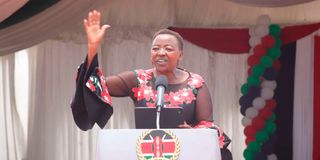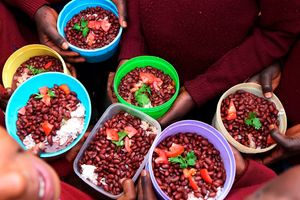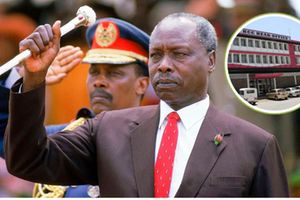
First lady Rachel Ruto is championing the reintroduction of the national school milk programme.
First Lady Rachel Ruto is championing the reintroduction of the national school milk programme, similar to former president Daniel Moi’s Maziwa ya Nyayo, through the Feed One End Hunger initiative.
A pilot project has already kicked off in Migori and Nakuru counties where pupils receive a packet of milk twice a week for a year.
If successful, the programme could become one of President William Ruto’s key legacy projects.
On Friday, the First Lady met dairy sector stakeholders, including the Kenya Dairy Board and 40 milk processors, to discuss the nationwide rollout. Processors have pledged support citing the programme’s nutritional and economic benefits.
“Many of us recall the impact of Maziwa ya Nyayo, which boosted school attendance and nutrition. We seek to build upon that legacy. A packet of milk in each child's hands unlocks their future, empowers farmers, and drives our country's economic growth,” she said.
The First Lady emphasised that the programme is in line with the government's 100 percent school enrolment policy and will also improve the nutrition of school children.
The government is working with milk processors, including the State-owned New KCC Limited, to ensure a steady supply of milk to schools.
Education experts have backed the initiative, highlighting its potential to improve school attendance and nutrition while strengthening the local dairy value chain.
“A school milk programme will help tackle malnutrition, increase enrolment rates, and provide farmers with a ready market,” said Prof Tom Nyamache of Turkana University.
The first school milk programme under President Moi covered 4.3 million pupils in 11,000 public primary schools. It primarily targeted children aged five to seven with a focus on improving their health.

First lady Rachel Ruto is championing the reintroduction of the national school milk programme.
Thirsty for free milk, learners remained in school and just like the current initiative, Maziwa ya Nyayo provided a packet of milk twice a week. Several county governments have already embraced school feeding and milk programmes to keep learners in school.
While most of these initiatives target pre-primary school children, the goal remains the same: to keep children in school.
Some of the counties running school milk or feeding programmes include Uasin Gishu, Nakuru, Bomet, Kericho, Mombasa, Trans Nzoia, Baringo, Homa Bay, Makueni, Embu, Nandi, Kajiado, Narok, Samburu, Nairobi, Nyandarua, Meru and Murang'a.
In Nairobi, Governor Johnson Sakaja’s administration runs a school feeding programme dubbed Dishi na County.
In Uasin Gishu, the county government supports the county ECDE School Milk programme, launched by Governor Jonathan Bii in 2023. The initiative provides milk to over 40,000 learners in 687 ECDE centres twice a week.
The Kenya Dairy Board has long pushed for the revival of school milk programmes. In 2015, the board held discussions with counties to encourage adoption, with the aim of creating a sustainable market for locally produced milk while increasing school enrolment.
Mombasa was the first county to implement a school milk programme in September 2014, providing milk to over 35,000 nursery and lower primary school pupils every school day.
Former president Moi introduced the free school milk programme in 1979, and it became a game changer for millions of Kenyan children.
The sight of tiny milk packets arriving in schools was motivation for many pupils to attend classes.
Within the first year of the programme, school enrolment, particularly in rural areas, shot up by over 23 percent. The initiative, which ran for nearly two decades, faded away in the mid-1990s due to funding constraints.







